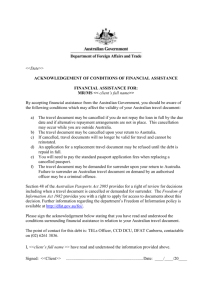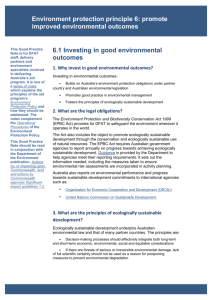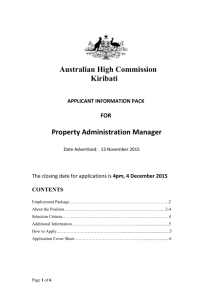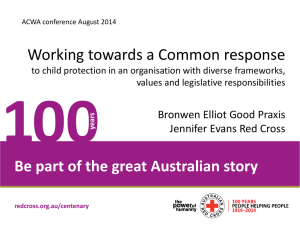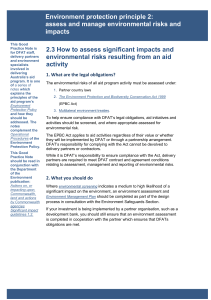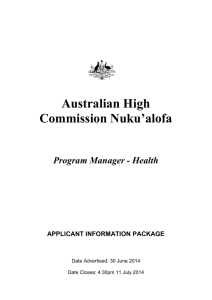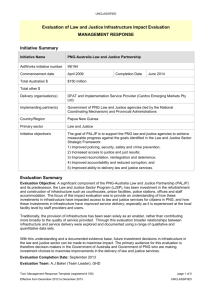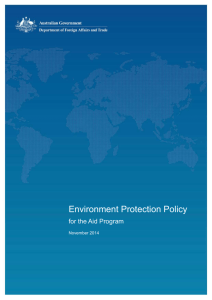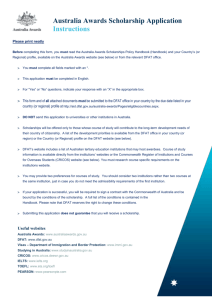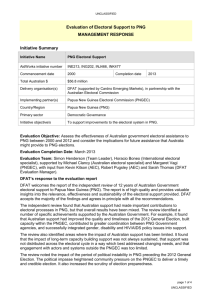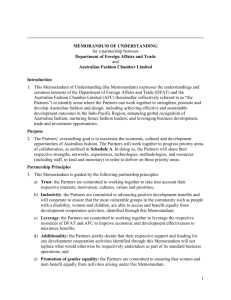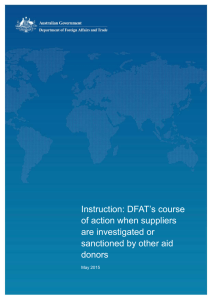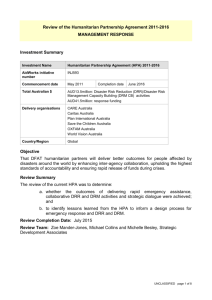2.5 DFAT
advertisement
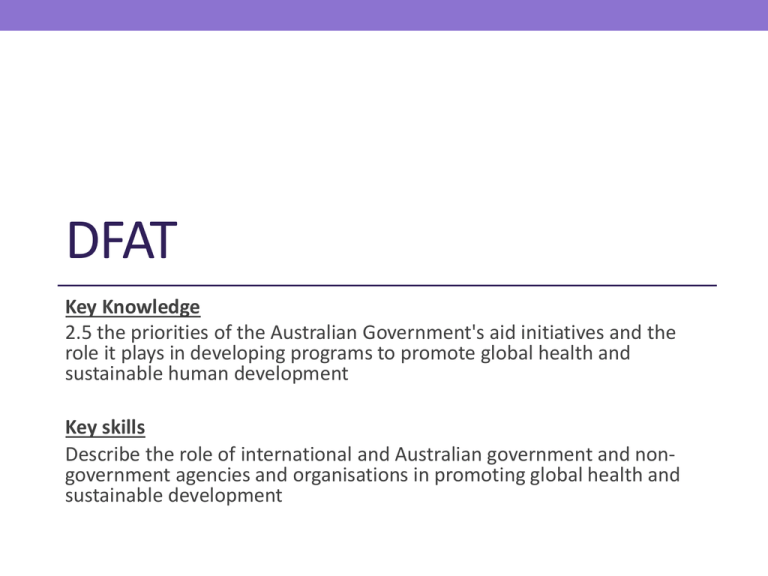
DFAT Key Knowledge 2.5 the priorities of the Australian Government's aid initiatives and the role it plays in developing programs to promote global health and sustainable human development Key skills Describe the role of international and Australian government and nongovernment agencies and organisations in promoting global health and sustainable development DFAT- Department of Foreign Affairs and Trade • DFAT is the Australian Government department that focuses on providing Official Development Assistance (ODA). • The purpose of the Australian Government’s aid program is; • to promote sustainable human development by working to reduce poverty in developing countries • promote Australia’s national interests by contributing to sustainable economic growth and poverty reduction. • to provide Official Development Assistance (ODA) to a number of developing countries • to assist developing countries achieve the Millennium Development Goals WHERE AUSTRALIA GIVES AID • Australia's aid program focuses on the Indo-Pacific region. • Internationally recognised for our leading role in the region, particularly in PNG and the Pacific. • Australia also provides assistance to Africa, the Middle East, Latin America and the Caribbean. How DFAT provides Aid Australian Government contributes to aid programs in a number of ways including by: • Providing funds to international organisations such as the United Nations. • Other examples: World Bank/World Health Organisation • Allows Australia’s aid program to be part of large scale projects that are too big for individual countries alone. • Assist with accelerating MDG’s • 1/3 of aid budget goes to multilateral aid. • Forms bilateral partnerships with developing countries. • Provides aid to 75 countries • Most our neighbouring regions • Aid can include funding, donations of materials, training and advice. • Works with governments to eventually become self sufficient. • Funding non-government organisations. • E.g World Vision Australia/Australian Red Cross • 6% of funding goes to NGO • Enable aid to reach the most vulnerable, are small community based projects and involve people with expertise. • Providing humanitarian assistance in times of need. Note: All Australians contribute to Australia’s aid program. Every week, about $3.30 in taxes from each eligible Australian goes toward paying for our aid program. This is about 1 per cent of the Australian Government’s expenditure and approximately .37% of Gross National Income (GNI). DFAT PRIORITIES Economic development, including encouraging trade and private sector investment • Priorities all contribute to breaking the cycle of poverty in developing countries. • Addressing the priorities, will allow for changes to occur that will promote health and human development in the future Humanitarian aid Health, including supporting the fight against HIV/AIDS, malaria and tuberculosis DFAT PRIORITIES Effective governance Education Empowering women and girls 1. DFAT PRIORITIES: ECONOMIC DEVELOPMENT, INCLUDING ENCOURAGING TRADE AND PRIVATE SECTOR INVESTMENT • Economic development- relates to increasing opportunities for employment and increasing average incomes. • A developed economy provides many benefits to global health and sustainable human development, including: • More taxation revenue: • Can be used by governments for resources such as infrastructure (including roads and communications systems), education, health care and social security. • This assists the population in accessing knowledge and the resources required for a decent standard of living. • Health care can decrease rates of communicable diseases such as malaria and HIV/AIDS. • Greater employment opportunities for individuals: • Can provide individuals with an income which can then be used to provide resources such as food, water and adequate housing. This increases the ability of people to lead long, healthy and productive lives, in accordance with their needs and interests. • Increased ability to develop new industries that can contribute to future economic growth. This improves opportunities for future generations to enjoy a decent standard of living. • Increasing trade and private sector investment are two ways that countries can develop their economies. 1. DFAT PRIORITIES: ECONOMIC DEVELOPMENT, INCLUDING ENCOURAGING TRADE AND PRIVATE SECTOR INVESTMENT GLOBAL TRADE PRIVATE SECTOR Enables developing countries to have the opportunity to earn an income from selling goods and resources, including to developed countries. - This increases the economy of developing countries and increases average incomes. - Extra income can reduce poverty and assist individuals and communities in providing the resources required for a decent standard of living such as food, water, sanitation, health care, education and housing. Includes self employed people including farmers and street vendors, small and medium sized businesses, through to large locally owned firms and multinational corporations. EXAMPLES: - Providing practical assistance and advice to help developing countries participate and be competitive in the global trading system. This includes sending economists and other experts to work with governments and the private sector in developing countries. Barriers to international trade are identified and solutions developed. - Provide funding for infrastructure development to assist countries in trading. Examples include road construction which the Australian Government has funded in many developing countries. This assist the movement of goods and resources to other countries. - Training local people in areas relating to global trade including agricultural trade, competition policy and intellectual property. - In PNG, improved air freight processing times from 4 days to 1 day from streamlined cargo inspection times, implemented with Australian technical assistance. By increasing the ability of PNG to process freight they are able to trade more efficiently and enhance their economy. EXAMPLES: - Providing microfinance loans so individuals can start their own businesses. Involves lending small amounts of money with low interest rates so people can purchase the resources they need to start a business (e.g a cow or sewing machine) - Providing funding and education to assist with improving skills and therefore increase their employability. - Building better environments for business. This includes advising on business registration processes, implementing contract laws, establishing institution to provide support to business and providing businesses with access to finance. - Provide infrastructure that assists with businesses in their operations such as providing a consistent electricity supply and ICT systems. Essential in developing the economy of a country- approx. 90% of jobs in developing countries are created in the private sector. 2. DFAT PRIORITIES: HEALTH INCLUDING SUPPORTING THE FIGHT AGAINST HIV/AIDS, MALARIA AND TUBERCULOSIS • Many developing countries experience poor health outcomes – leads to poverty cycle and low level of HD. • Australian government focuses on improved health – HIV/AIDS, malaria and TB through provision of food, safe water, sanitation, trained health workers, disease prevention etc. HEALTH EXAMPLES - Through a bilateral partnership with the Indonesian Government, Australia provided funds for approximately 600,000 people in Indonesia to gain increased access to safe water, and around 110,000 additional people to gain access to basic sanitation or a public toilet. Improving access to safe water and sanitation assists in reducing the rate of infectious diseases and promotes health. - Contributes to GAVI Alliance (a multilateral organisation) to provide immunisation to children in developing countries against major diseases. - Vaccinating 900 000 children in Papua New Guinea since 2009 - Reducing malaria by 80 per cent in Vanuatu - Expanding access to essential basic health services in Afghanistan from less than 10% of the population in 2001 to around 85% in 2012. 3. DFAT PRIORITIES: EDUCATION • Education: key to reducing poverty and improving SHD. • By being educated, people can gain the skills that will enable them to contribute to the country’s economy in the future. • Giving girls an education leads to many other benefits. Educated women have better maternal health, fewer children, healthier children and increased economic opportunities, and are likely to marry later in life. They are also more likely to send their own children to school which increases sustainability. • The Australian Government considers education to be one of the best investments it can make to reduce poverty and achieve sustainable human development. As a result, Australia has committed $270 million to the Global Partnership for Education (GPE) from 2011–15. Australia's investment is expected to contribute to help 20 million children enrol in school, provide 40 million new textbooks in classrooms, and train 500,000 teachers. EDUCATION EXAMPLES - Contributing along with other donors to help seven million children in Afghanistan attend school. Helping 330 000 poor children in Indonesia attend school by building more than 2000 schools. Helping the poorest Bangladeshi families with skills training, income support and basic health care. Training more than 20 000 people from developing countries at Australian institutions in areas from public administration to medicine. Providing scholarships to students in Laos from disadvantaged backgrounds to study at a Lao university and increasing access to knowledge. Contributed to the abolition of school fees in PNG for the first three grades of school. 4. DFAT PRIORITIES: EMPOWERING WOMEN AND GIRLS • Women and girls in developing countries often lack the same opportunities available for males in terms of education, employment and making decision that affect their lives. • It is estimated that the Asia-Pacific region is losing up to US$47 billion annually because of women’s limited access to employment opportunities, and up to US$30 billion annually due to gender gaps in education. • By empowering women and girls, benefits are felt throughout the community with higher average incomes, greater levels of education and healthier families. • The Australian Government has set a target requiring that at least 80 per cent of investments, regardless of their objectives, will effectively address gender issues in their implementation. EMPOWERING WOMEN AND GIRLS EXAMPLES - the Australia–Pacific Women Parliamentarians Partnership Program to help address the low levels of women’s representation in Pacific politics. Supports UN Women: works with Governments to provide relevant technical insight and also works to improve coordination of gender equality within the UN systems. In 2012–13, Australia helped 24 772 women survivors of violence access critical services such as emergency shelters, counselling and legal advice in countries and regions including Nepal, Sri Lanka, Timor-Leste, Papua New Guinea, Solomon Islands, Vanuatu, Fiji and Sub-Saharan Africa. 5. DFAT PRIORITIES: EFFECTIVE GOVERNANCE • Governance impacts on all aspects of a country’s society and economy. • Stable, productive governments can work to promote the health and human development of the population. • An effective government provides the foundations for economic growth, private sector investment and trade. • Well-functioning governments can work to provide stability and maintain law and order by ensuring disputes among citizens are settled peacefully and fairly. • They can deliver education and health services that build a skilled, productive and healthy workforce. • However, where governance is poor, development outcomes are also poor. EFFECTIVE GOVERNANCE EXAMPLES - Provided advice to governments of developing countries relating to financial management and the establishment of institutions such as health systems, police forces and legal systems. Supported PNG election through logistics, training and security coordinator. Supported election observers, helped voter education to be delivered and supported training for women candidates. Helped countries such as the Solomon Islands to improve budget processes, allowing them to meet debt obligations and increase revenue 6. DFAT PRIORITIES: HUMANITARIAN AID • Provided in crisis situations such as natural disasters and human-induced emergencies, where human life is at immediate risk. • Causes of these situations include earthquakes, bush fires, tsunamis, conflicts and chemical spills. • Australia’s goal for humanitarian action is to save lives, alleviate suffering, and maintain human dignity during and in the aftermath of humanitarian crises. • The Australian Government recognises that humanitarian action saves lives and helps people get back to leading productive lives more quickly. HUMANITARIAN EXAMPLES - - Sending staff to affected areas to provide immediate support (emergency/humanitarian aid). The Government has established a warehouse in Brisbane that contains around 100 tonnes of emergency supplies including medical kits, blankets, temporary shelter, food ration packs and drinking water. When required, these supplies can be transported to areas experiencing a crisis. Working in partnership with the World Food Programme to deliver 45 693 tonnes of food to help Funded NGO such as the Red Cross to provide assistance during times of crises. Providing food, shelter, water, sanitation and medical care in response to the ongoing humanitarian crisis in Libya, where almost one million people were displaced by conflict.


